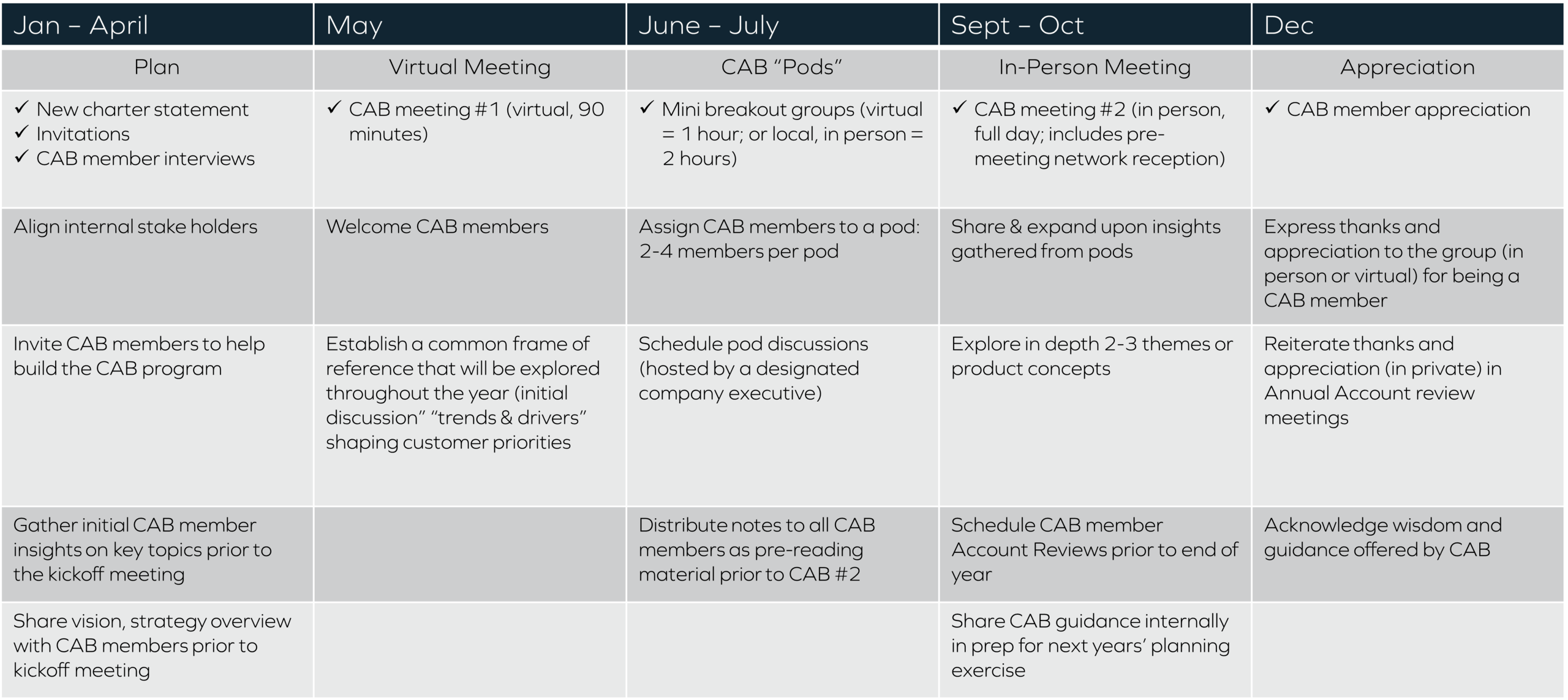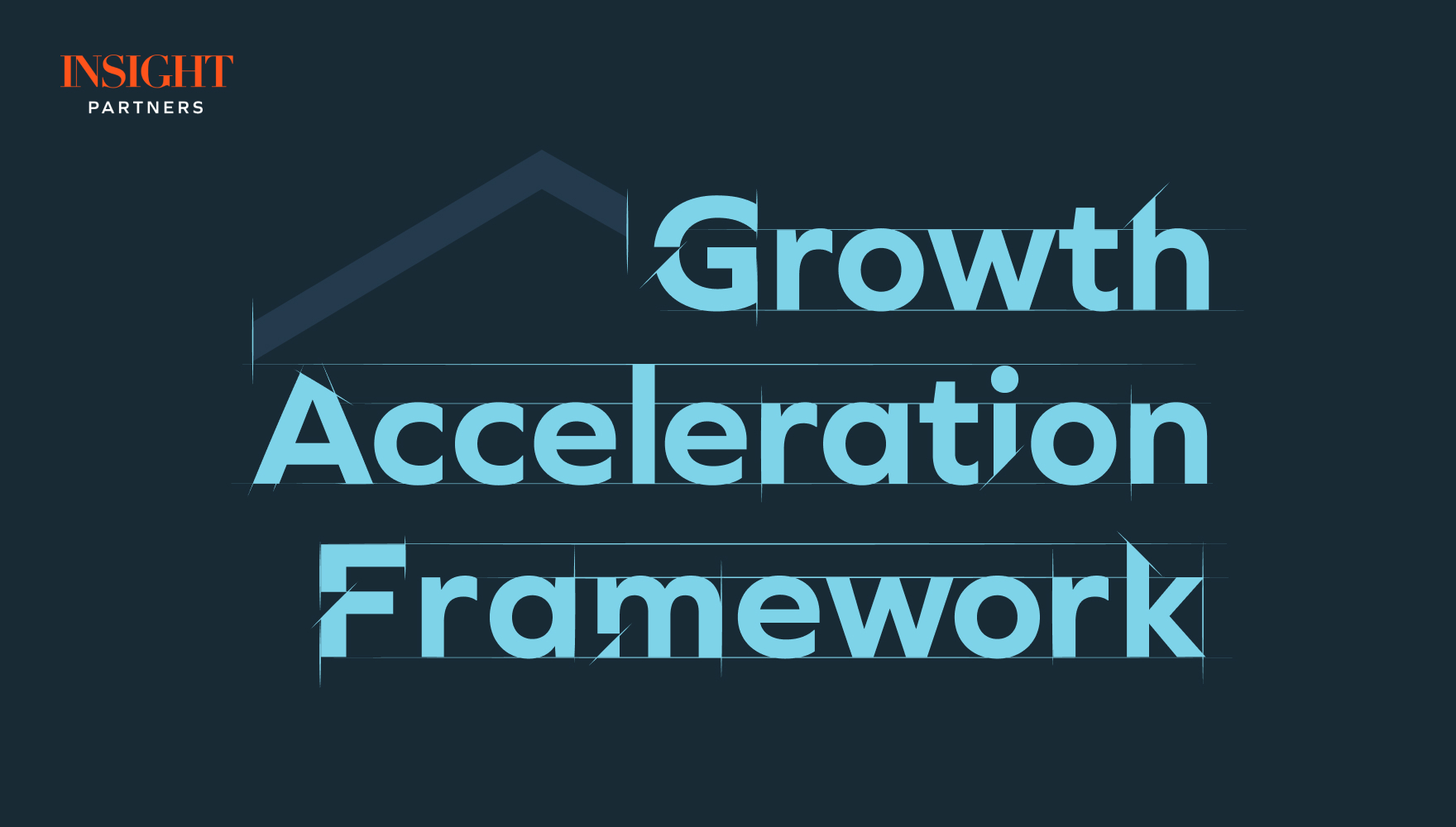Customer Advisory Boards: How to Launch and Manage a Successful Program in 2022

While Customer Advisory Boards, or CABs, have become a popular and widely used method of magnifying the voice of the customer in recent years, there remains a fair amount of misunderstanding about what they are and the purpose they serve.
To demystify CABs and understand how to leverage them successfully, we invited Mike Gospe, Customer & Partner Advisory Board Strategist, to share some insights he's gained over his 20 years of building out, operating, and evolving CAB programs. In this blog, we cover CAB fundamentals, present a case study from BigPanda (an Insight portfolio company), and share some valuable lessons learned from our recent CAB event.
To action the guidance in this blog, download our Customer Advisory Boards Guide beneath this page.
What is a CAB program and how does it fit into the larger VoC (Voice-of-the-Customer) Model?
A Customer Advisory Board is a program, not a meeting. It’s a commitment to maintaining a cadence of forward-focused strategy and roadmap discussions designed to encourage business alignment between your executives and your customer. To break CABs down into their components:
- Customer: Apart from your company's executives and facilitators, only a select list of customers are invited – not prospects, industry analysts, or guest speakers. “This is a very exclusive, candid conversation between an executive team and customers. If you invite others, it changes the dynamic and the psychology of the conversation.”
- Advisory: The purpose of a CAB is to get advice and direction from customers on how their businesses are changing, and what your company can do to support them. This means “80% of the time, your executives are quietly listening.”
- Board: Preparing for a CAB requires the same respect and intensity that goes into preparing for a Board of Directors meeting. “The worst thing you can do is throw together a few slides 24 hours before the meeting and parachute in.”
CAB is all about strategy – it is not a product focus group, a customer appreciation event, or a sales meeting. Here is how CAB fits into the broader Voice-of-the-Customer program:

CABs are focused on longer-term strategic direction rather than tactical and operational feedback. A CAB is not a product or sales focus group aimed at getting feedback on specific product features or to help you understand why customers are churning. It is a forum to ask your customers strategic questions that will make an impact 2-3 years from now. An example of a strategic question that may be top of mind at your company: “What do you think your biggest challenges will be coming out of COVID?”
When should you start a CAB program?
While CAB programs are extremely valuable in the right context, they are not for every company. One way your company can determine your CAB readiness is by taking inventory of all the customer interactions you are having today. As you do this, you will likely discover gaps in your VoC strategy, and if there is a gap in “Strategic Direction,” that is where a CAB might fit in. In addition, here are 7 signs that a company may be ready to start a CAB program:
- You have over 50 paying customers. This indicates that there is sufficient history upon which to build a forward-looking business hypothesis that you’d like to validate.
- Your industry is changing. Your customers are rethinking their business, operational, and investment strategies because of changes in the industry.
- You are ready to act. Your organization values the “voice of the customer” as an important piece of market research and will make changes based on customer input and feedback.
- Your entire executive staff is on board. Executives should be ready and eager to fully sponsor and support your cross-functional CAB initiative. This is not a “marketing special project.”
- You have strategic questions for customers. These questions are about how their businesses are changing and what you can do to help them succeed. They are not getting answered in any other forum.
- Your CAB cadence aligns with annual planning. You are ready to integrate your CAB with your annual planning process as well as other high-priority meetings or initiatives on your calendar.
- Your leadership team wants to listen. Your leadership team is genuinely interested in listening to customers and understanding what they think. Your organization recognizes that learning from customers and showing empathy is a competitive differentiator.
For further details on when to start a CAB program, check out Mike Gospe’s 7 signs your company is ready for a CAB program.
What is the value of a CAB program?
In our recent CAB webinar, Mike Gospe, CAB strategist & facilitator, shared a recent story of how a multi-touch CAB program helped transform one company from a lagging start-up into a unicorn with a $150B valuation.
Mike Gospe, CAB Strategist & Facilitator:
“A tech start-up was founded in 2016. Their CEO contacted me in 2019 and told me, ‘I think we’re having a churn problem, and I need you to help us figure out why we are losing customers and not growing faster.’ So, we formed a CAB program designed to explore the business and operational issues these customers were wrestling with. We also wanted to gather their priorities (as they related to the business problem the CEO’s company was helping to solve), and what he and his team could do better. We learned a lot and experienced two major ‘A ha!’ moments.
“We initiated a CAB program in 2019. After conducting a series of CAB member interviews and a formal CAB meeting, we discovered that this company did not have a churn problem at all. These ‘customers’ loved the company. However, not everyone was a ‘true’ customer. Some were actually partners. The gray area between ‘customer’ and ‘partner’ confused their business journey hypothesis. This was ‘A ha!’ moment #1.
“The second ‘A ha!’ moment was related to what the CEO viewed as a strength: the willingness and ability of the CFO and CTO to parachute in to solve customer problems. While nimbleness and attention to detail is a strength these customers deeply appreciated, this type of behavior did not scale. Customers told the CEO, ‘Your hero approach makes me worry that you might not be enterprise-ready.’ We asked customers to tell us more about what it means to be ‘enterprise-ready.’ It had nothing to do with the products and services and everything to do with how the company was going to market and the psychological impact it had on how they viewed the company.
“This first CAB meeting became the first of a series of strategy-level discussions, some taking place in-person, others virtually (during the pandemic). The company had diligently used the input to reshape what its organization looked like. The CAB helped the company form a new customer success team, adopt a brand-new model for sales and partners, improve the customer onboarding process, and guide the leadership team to become ‘enterprise-ready.’ ”
How do you get started?
If you have determined your company is ready to start its first CAB program, you may be wondering "how do I get started?" How you start goes hand in hand with what you want to learn, and what you are prepared to do with the information you collect. Here are some general guidelines:
- Step 1: Set clear objectives. Determine what you want to achieve with your overall CAB program and what you want to learn from the first (and future) engagements.
- Step 2: Identify themes/big questions. What do you want to explore with your customers? Design “big questions” suitable for a strategic conversation.
- Step 3: Invite customers. Create a list of 8-12 customer C-Suite representatives who are best positioned to respond to the theme and engage in constructive dialogue. It’s important to invite the right customers to answer the right questions.
- Step 4: Craft the agenda. Build an agenda focused on discussion topics, not lectures. In particular, the agenda should follow the 80/20 rule, where customers do the talking 80% of the time, and your team does 80% of the listening.
- Step 5: Prepare and build your content. Share background material prior to the meeting so CAB members are prepared. Pre-meeting materials may include a charter statement, agenda, CAB member bios, pre-reading articles, a short video message from your CEO, etc.
For more details on how to design your first CAB program, read Mike Gospe's post 5 Steps to designing your CAB program.
CAB Guidance from Big Panda
Preparation is crucial. It is never too early to start planning. We suggest a 3-month runway at minimum between your internal kickoff and your first CAB meeting. The earlier you start, the better. In our recent CAB event, Mohan Kompella, the CAB executive sponsor at Big Panda, shared five lessons learned throughout his company's CAB journey.
- Set a clear CAB charter. The charter clearly explains the objectives and expectations associated with your CAB. Use an internal version of the charter to align the executive team. Draft a separate “customer-friendly” version you can share with all CAB members. “The first lesson we learned is that it’s important to define your CAB program well…the program should be exclusive and so elevating the quality of the discussion.”
- External, neutral facilitators can be effective. “There are certain things facilitators can do well that someone internal would find difficult to do (like ensuring one customer doesn’t dominate the discussion)—a neutral CAB expert added a lot of value for us.”
- Small groups work better for a virtual CAB session. “If you have more than 6-8 people in a Zoom session, it becomes hard to foster the type of engagement and discussion you need. You might end up with 2-3 dominant voices in the group, and half of the participants will be silent. We ended up grouping our participants by time zone and customer maturity (e.g., advanced, just getting started), which helped a lot with the discussion. Again, a facilitator will help ensure your virtual meetings work well.”
- Customer stories are compelling and effective. “We infused our last CAB session with customer stories. For example, we had someone share their vision for their organization that’s using BigPanda, where they think they are going to be 3 years from now, and what they have done to lay the ground to get to that point. The story fostered a lot of discussion and engagement.”
- The social aspect of CAB programs is important. “The people who are part of our CAB are VPs, Senior Directors, and mostly Fortune 1000 companies. Many of them have not met before. It is hard for them to open up even though the CAB sessions are supposed to be a safe space. We needed icebreakers and social events. For our virtual CABs, we had wine or champagne tasting shipped to our participants for Day 1. On Day 2 we conducted the CAB session for the first group of 6-8 people. On Day 3 we hosted a separate session for the second group. So far, this structure has been working very well.”
What do CAB programs look like in 2022?
Prior to the pandemic, CAB meetings were typically one-day in-person meetings with a networking reception/dinner the evening before. During the pandemic, this model shifted dramatically into three or four 90-minute virtual meetings scheduled over the course of a year. Periodic virtual meetings allow CAB conversations to grow over time, and they invite CAB members and executives to meet more often between meetings.
As the world adapts to a “new normal,” Mike Gospe believes that CAB programs will likely be hybrid, including both in-person and virtual elements. “Some of my clients will continue to use only virtual meetings because they are less expensive, making it easier for customers in remote locations to easily participate. Others are eager to transition back to full in-person engagements. The pandemic has helped us discover more tools for CAB programming. All are good if used appropriately.”
Mike proposes the following integrated CAB program model that leverages the strengths of virtual and in-person programs:

To learn more about hybrid CAB programs, read Mike Gospe’s What is a hybrid Customer Advisory Board program?
What’s next?
Now that you have a foundational understanding of CABs and the value they bring to a business, we encourage you to share this content with your executive team to determine whether a CAB program makes sense for your company at this stage of growth.
For more information, check out Mike Gospe’s CAB Resource Center and/or contact him at mikeg@kickstartall.com to schedule a no-cost consultation, free to all Insight Partners portfolio companies.
Explore the SaaS Growth Acceleration Framework
Explore this topic and 40+ other critical business considerations in our interactive SaaS Growth Acceleration Framework for founders and GTM leaders.Here’s how SaaS leaders ($10m + ARR) can use this framework to win:
- Understand the downstream implications of 40+ critical business decisions
- View how product-related decisions can shake the foundation of your go-to-market strategy
- Dig deeper into any GTM component to view key questions you should be asking when making changes
CAB 101 Guide
To jumpstart your CAB program, download our CAB 101 Guide below.








